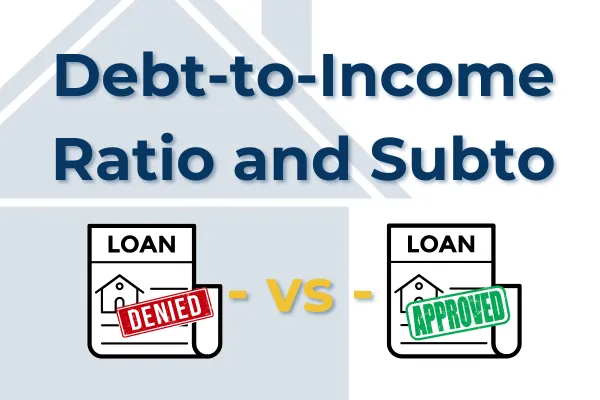
Debt to Income Ratio and Subto Sales
Can You Get Another Loan After Selling Your House Subject To Your Current Loan?
If you’re selling your house subject to your current loan and wonder if another mortgage is in your future, the answer is almost always yes. As long as you've got a decent credit score, you’ll likely have no trouble qualifying for a new loan.
To qualify for a home loan, you'll have to pass your lender's Debt-to-Income (DTI) analysis. This is true whether you've already got a loan or not.
What Is DTI?

Debt-to-Income (DTI) ratio measures how much of your income goes toward monthly debt payments. When you sell a home subject to an existing loan, that mortgage still shows on your credit report, which can raise your DTI. Lenders can adjust this if you provide proof, like a lease agreement or bank statements showing someone else is making the payments. Lowering your DTI with this documentation can significantly improve your chances of loan approval.
How Lenders View Subto Transactions
When you sell a house subject to an existing loan, the original mortgage remains in your name. From a lender's perspective, this is your debt and directly affects your DTI ratio. A high DTI can make lenders reluctant to lend, but there are established ways to ensure it doesn’t stop you from getting approved.
If You’re Buying Again Within 12 Months (the 75% write-off)
If you plan to purchase a home within the next year, lenders often handle this situation under what’s called “Departing Residence” or “Primary Conversion.” In simple terms, lenders can use a lease or promissory agreement to discount your DTI ratio by up to 75% of your old mortgage payment. This reduces the weight of the existing loan on your DTI and improves your chances of qualifying for a new mortgage.
The trick is asking the lender what documentation they require so you can work with your buyer to sign documents that satisfy the lender's requirements.
Sometimes this is a lease. Sometimes, it's a promissory note and/or wraparound mortgage. Ultimately, your documentation proves for the lender that someone else is responsible for paying that debt, meaning it shouldn't affect your DTI ratio much (or not at all).
The key is to find out what the lender wants to see. They don't always understand subto transactions, so let them use their preferred language, and you can match your paperwork to their requirements.
If You’re Buying After 12 Months (the 100% write-off)
When your home purchase timeline is more than 12 months after selling subto, lenders typically care less about leases and wrap notes, and mostly want to see evidence that payments are actually being made by someone else (and that they have been for the last 12 months).
This can be a combination of mortgage statements, bank statements from the buyer/payor's account, payment receipts from a loan servicer, sworn statements from the buyer/payor.
In this case, lenders can use typically discount your entire old mortgage payment from your DTI ratio. For most borrowers, this opens the door to full qualification for a new loan.
What Happens If a Lender Says No?
Some lenders just have stricter policies or are unfamiliar/uncomfortable with handling post-subto borrowers. If the first lender denies you, don’t stop there. The truth is, most borrowers secure approval within two or three attempts.
For perspective: Creative TC has never heard of a borrower with decent credit being unable to find a lender to offset their DTI and get approved for their next home purchase loan.
Bottom Line
Getting another loan after selling your house subject to your current loan is rarely a problem—especially if your credit score is in good shape. Whether you plan to buy within 12 months or later, there are established methods lenders use to adjust your DTI and help you qualify. The key is understanding the process, maintaining contact info between buyer and seller, having the right documentation, and a bit of determination.

